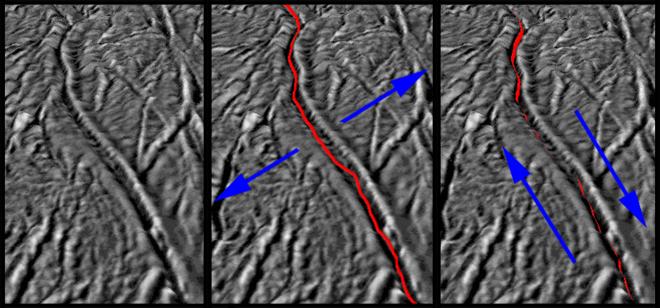Stress at Enceladus

| Language |
|
|---|
These images, based on ones obtained by NASA's Cassini spacecraft, show how the pull of Saturn's gravity can deform the surface of Saturn's moon Enceladus in the south polar region crisscrossed by fissures known as "tiger stripes." The blue arrows show the different kinds of stress that can occur at the tiger stripes, allowing jets of water vapor and organic particles to spray out. As Enceladus orbits Saturn, Saturn's gravitational forces can cause the fissure to pull apart (middle panel) or cause the two banks to move side-to-side like California's San Andreas Fault. The red stripe shows where gaps open because of motion and would be places where material could erupt.
The images here focus on the tiger stripe known as Alexandria Sulcus.
The Cassini-Huygens mission is a cooperative project of NASA, the European Space Agency and the Italian Space Agency. NASA's Jet Propulsion Laboratory, a division of the California Institute of Technology in Pasadena, manages the mission for NASA's Science Mission Directorate, Washington, D.C. The Cassini orbiter was designed, developed and assembled at JPL.
For more information about the Cassini mission, visit: http://www.nasa.gov/cassini and http://saturn.jpl.nasa.gov
Credit: NASA/JPL-Caltech/SSI/LPI/GSFC
